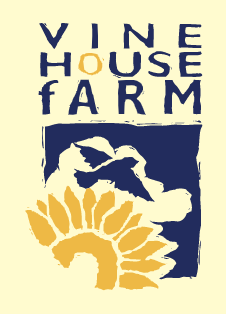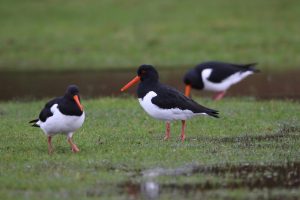
September has been wetter than average, 74mm or 2.9ins of rain. We’ve not had many nice autumn days that I would usually associate with September; it has been cooler than average. There have only been three cooler Septembers in the past 20 years, but in the 28 years prior to that, Septembers were a lot cooler. When I record this data, the results show that we are warming up and my theory is that we have warmer cloudy days and nights. When it is cloudy, it is like having a blanket over us and we are generating more heat than we used to; more vehicles, warmer homes and this heat keeps us warmer under that blanket.

For those farmers who did not get their harvest finished in August, it has been a tricky time as we had rain on 20 days in September. We always do have quite a bit of harvesting in September, with the canary seed, red millet, red clover and white millet, but we seem to have been coping and it is all in now – just the sunflowers left to harvest.
Although the rain has hindered us, in a way it has also been quite good for us. All the rape and the cover crops are growing well and we are able to lift our potatoes without bruising them, which is most important.
We belong to a potato group called Nene Potatoes, they market our potatoes and give us other advice. Every morning they send out a student to all those growers to collect a sample of potatoes that are being lifted on that day. They take the samples back to the office to assess their quality for damage and bruising. The potatoes are put in a hot box, which is a small room kept at about 35ºC, which brings out the bruising within 24 hours. The potatoes are examined and peeled, the results are then tabulated and all of the results are sent to all growers telling everyone how good or bad a job they are making of their lifting.
From those results we can adjust the harvester or the potato grader to try and eliminate the damage. Normally you cannot see a bruise on a potato until it is peeled. A bruise is a black spot under the skin which, when eating the potato, most of us would put to one side. Generally, if it is a dry time we get more bruising. If it is very dry we may even get the irrigator out and water the field, which softens the clods and allows us to lift with less bruising.
Later in the year, or even in a few days time, Nene will be selling our potatoes. They will have a record of every field of every grower and will try to match each field of potatoes to the buyer who likes, or will tolerate, that sample. Potatoes with bruising in them will be worth less. Nene have 100,000 tonnes to market through the year and through the expertise and honesty of all growers and staff concerned, they help us all to improve as growers and maximise our revenue.
Potatoes are just one of the things we are busy with at this time of year; we have drilled the oil seed rape; we have to prepare the soil in the fields that will be drilled with winter barley and winter wheat; ploughing for the spring crops and the sugar beet to take up.


Although our Swallows left the farm during the last week in August, and others have said the same, I continued to see Swallows for the first 20 days of September. On 20th September we harvested our crop of organic red clover and there were up to 150 Swallows flying around the combine; to me it was a magical sight. The crop was full of insects and no doubt the combine was killing a lot of them, but the Swallows were able to have a feast as they migrated South West. There were a few about the next day, one on 22nd September but I can’t remember seeing one since.
The trailer with the clover seed in was heaving with weevils, they were half an inch thick round the outside of the trailer. How they managed to survive after going through the combine, I have no idea, but they are still crawling around in the seed and all round the building where the seed is stored. Ladybirds don’t seem to be as tough as the weevils, quite a few of them were damaged but they are a bit bigger.
After the clover was harvested, the Herons, Kestrels and Buzzards moved in to harvest the voles. There were six or seven Herons on the field and in less than two hours I watched one adult Heron catch 10 voles. The last two voles were left on the field – it must have been full. A young Heron nearby only caught one in that time and it had made two attempts at catching other voles. That told me that young birds need a surplus of food, as they are inexperienced in finding and catching food. Look around the average farm in the Fens and you wonder where there is any food, as we have very few hedges, the dykes get mown and all the stubbles are worked. No wonder our farmland birds are declining.
I have been seeing Herons down the farm on our six metre grass margins for the past six weeks, well away from water. They aren’t there for a party, they are there for the food. That food would have been voles and that tallies up with the fact that I haven’t seen any Barn Owls flying in the day time. There are plenty of voles around in this area at the moment. I say ‘in this area’ because things can be so different only 50 miles away.
Tree Sparrows have also been taking up quite a bit of my time. I have been rearranging feeders on Vine House Farm and I now have 28 six port feeders hung up at one site and I have taken a photo of a Tree Sparrow on every port of every feeder. That means there were 168 birds on the feeders, there were 80 more on the ground, or in the bushes that I could see, and I expect there were at least another 100 in the bushes that I couldn’t see. I prefer to use the plastic Ring Pull Seed Feeders on the farm.
I have started erecting more nest boxes at new sites around the farm, I use Woodstone Nest Boxes, which are easy to open and are long-lasting. I have taken them from sites where there are too many nest boxes. People who have been monitoring Tree Sparrows at various sites say after a few years, they just disappear. This is because they run out of food, and by food I mean insects. They literally clear up all the insects that are suitable to feed to their young. Some of my sites, I believe, are running short of insects.
Talks, Walks & Events
We shall be selling our birdseed at various events this Autumn. All are great days out, well worth a visit
Sat 28th October:
Deepings Annual Ploughing Match
Sun 29th October:
National Hedge Laying Competition, Stourhead



